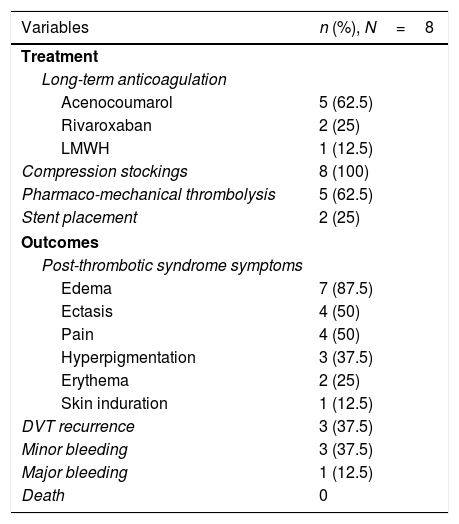To analyze the prevalence of May-Thurner syndrome (MTS) among patients with deep vein thrombosis (DVT) of left lower limb (LLL), and outcomes after long-term follow-up.
MethodRetrospective observational study that included patients older than 18 diagnosed with acute DVT and MTS.
ResultsAmong 760 patients diagnosed with DVT in the LLL, 8 patients were diagnosed with MTS (1.05%), with a mean age of 39 years. All patients received long-term anticoagulation, with a mean of 31.9 (±25.2) months. Invasive treatment with pharmaco-mechanical thrombectomy was performed in 5 patients (62.5%). During follow-up (mean of 32.4 months), 25% of patients suffered DVT recurrence. Only 1 case presented major bleeding, and no deaths were registered.
ConclusionsMay-Thurner syndrome constitutes a permanent and underdiagnosed risk factor for the development of DVT of LLL. Our findings suggest that long-term anticoagulation therapy might be considered in selected cases.
Analizar la prevalencia del síndrome de May-Thurner (SMT) en una cohorte de pacientes con trombosis venosa profunda (TVP) en el miembro inferior izquierdo (MII), y las complicaciones durante el seguimiento a largo plazo.
MétodosEstudio observacional retrospectivo que incluyó a pacientes mayores de 18 años con diagnóstico de TVP en el MII y SMT.
ResultadosEntre los 760 pacientes diagnosticados de TVP en el MII, ocho pacientes fueron diagnosticados de SMT (1,05%), con una media de edad de 39 años. Todos los pacientes recibieron tratamiento anticoagulante a largo plazo, con una media de 31,9 (± 25,2) meses. Se realizó tratamiento invasivo con trombectomía fármaco-mecánica en cinco pacientes (62,5%). Durante el seguimiento (media de 32,4 meses), el 25% de los pacientes sufrieron recurrencia de TVP. Solo se registró un sangrado mayor y no se registraron muertes.
ConclusionesEl síndrome de May-Thurner constituye un factor de riesgo infradiagnosticado y permanente para el desarrollo de TVP en el MII. Nuestros hallazgos sugieren que la anticoagulación a largo plazo podría ser considerada en casos seleccionados.








